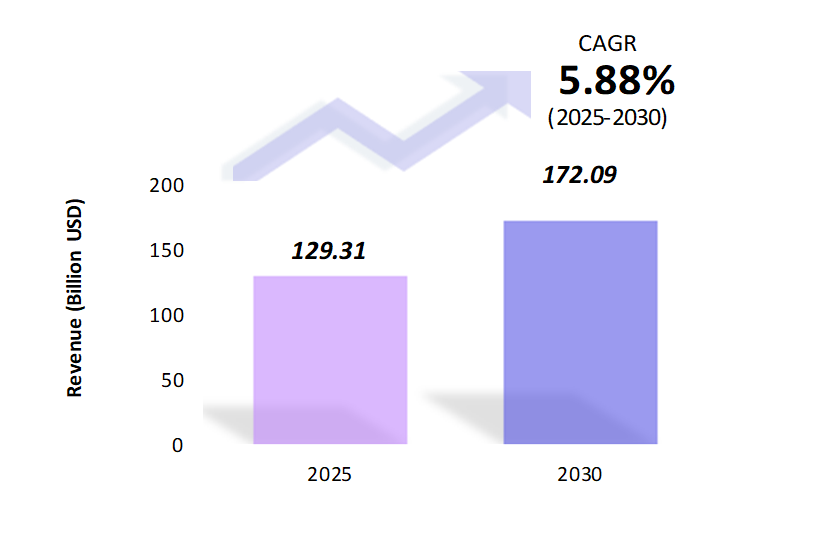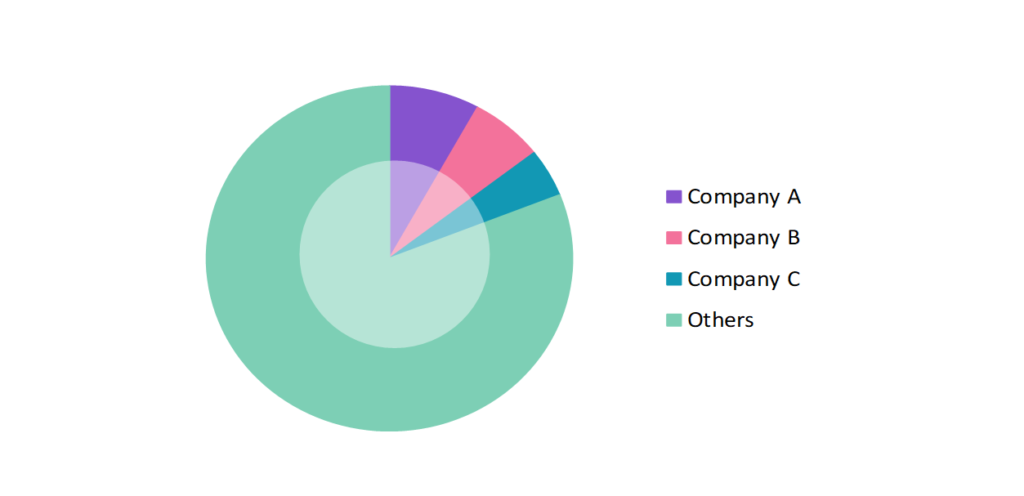Returnable Packaging Market: Size, Share, Trends & Forecast (2024-2029)
The market report provided a comprehensive analysis segmented by Product Type (Pallets, Crates, Intermediate Bulk Containers, Dunnage, Drums & Barrels, Bottles, Others); by End Use Industry (Food & Beverages, Automotive, Consumer Durables, Healthcare, Others); by Geography (North America, South America, Asia Pacific, Europe, The Middle East, Africa).
Outlook

- The returnable packaging market is estimated to be at USD 129.31 Bn in 2025 and is anticipated to reach USD 172.09 Bn in 2030.
- The returnable packaging market is registering a CAGR of 5.88% during the forecast period 2025-2030.
- The returnable packaging market is driven by increasing environmental awareness, cost-efficiency benefits, and regulatory mandates pushing for sustainable practices across industries. Innovations in tracking technologies, such as Radio Frequency Identification (RFID) and the Internet of Things (IoT), are improving asset management and reducing losses in reusable packaging systems. As demand for sustainable solutions grows, industries like automotive, food, and healthcare are progressively adopting returnable packaging to minimize waste and streamline supply chains.
Request a free sample.
Ecosystem

- The participants in the global returnable packaging industry are always developing their strategies to preserve a competitive advantage.
- Companies are differentiating themselves by developing eco-friendly and recyclable materials, such as biodegradable plastics and high-durability composites. This aligns with increasing environmental mandates and consumer demand, giving companies that lead in sustainable practices a stronger market position.
- Several important entities in the returnable packaging market include Brambles Ltd.; Schoeller Packaging B.V.; DS Smith Plc; Myers Industries Inc.; Nefab AB; and others.
Ask for customization.
Findings
| Attributes | Values |
|---|---|
| Historical Period | 2019-2023 |
| Base Year | 2024 |
| Forecast Period | 2025-2030 |
| Market Size (2025) | USD 129.31 Bn |
| Market Size (2030) | USD 172.09 Bn |
| Growth Rate | 5.88% CAGR from 2025 to 2030 |
| Key Segments | Product Type (Pallets, Crates, Intermediate Bulk Containers, Dunnage, Drums & Barrels, Bottles, Others); End Use Industry (Food & Beverages, Automotive, Consumer Durables, Healthcare, Others); Geography (North America, South America, Asia Pacific, Europe, The Middle East, Africa) |
| Key Vendors | Brambles Ltd.; Schoeller Packaging B.V.; DS Smith Plc; Myers Industries Inc.; Nefab AB |
| Key Countries | The US; Canada; Mexico; Brazil; Colombia; Chile; China; India; Japan; South Korea; The UK; Germany; France; Netherlands; Turkey; UAE; Israel; Egypt; South Africa |
| Largest Market | Asia Pacific |
Get a free quote.
Trends
- Smart Tracking and IoT Integration: Advanced returnable packaging now integrates IoT (Internet of Things) technology, which enables real-time tracking of containers and pallets through Global Positioning System (GPS) and Radio Frequency Identification (RFID). PAKi Logistics uses smart pallets equipped with sensors to monitor location, temperature, and handling conditions, which ensures better inventory management, reducing loss, and optimizing supply chains.
- Use of Lightweight and Durable Materials: Innovations in materials, such as advanced polymers and composites, are making returnable packaging lighter yet stronger, which reduces transportation costs and environmental impact. For example, Schoeller Allibert has developed lightweight plastic crates that are just as durable as traditional materials, which allows more energy-efficient logistics while maintaining structural integrity for multiple uses.
- Integration of Automated Cleaning and Sterilization Systems: Automated cleaning systems for returnable packaging, especially in industries like pharmaceuticals and food, improve hygiene standards and reduce labor costs. Innovations by companies such as Kärcher provide automated washing and sterilization solutions for reusable crates, bins, and pallets, which make it easier to meet regulatory standards and maintain safe, reusable packaging.
Speak to analyst.
Catalysts
- Environmental Sustainability Initiatives: With a growing focus on reducing plastic waste and promoting circular economies, companies are increasingly adopting returnable packaging to lower their environmental impact. Government regulations and consumer demand for eco-friendly practices encourage industries to replace single-use packaging with reusable options, which helps reduce landfill waste and supports corporate sustainability goals. Coca-Cola introduced refillable glass bottles in certain markets, including Latin America and parts of Europe. In these regions, Coca-Cola has shifted from single-use plastic bottles to glass bottles that can be returned, cleaned, and reused multiple times.
- Cost Efficiency in Supply Chains: Returnable packaging offers long-term cost savings by minimizing the need for single-use materials, reducing packaging waste, and optimizing logistics. Reusable crates, pallets, and containers cut down on recurring packaging expenses and transportation costs, particularly in industries with high shipment volumes like retail and automotive, which makes it a financially attractive solution for businesses.
- Stringent Industry Regulations and Safety Standards: Industries such as pharmaceuticals, food, and chemicals face strict regulations on packaging standards for hygiene and safety. Returnable packaging solutions, which can be cleaned, sterilized, and reused, help companies comply with these requirements more sustainably. This need for regulatory compliance while minimizing waste drives demand for high-quality, reusable packaging solutions across these sectors.
Inquire before buying.
Restraints
- Varying Environmental Mandates Across Regions: Different regions impose unique environmental regulations, creating compliance complexities for companies operating globally. While some regions strongly promote reusable packaging with incentives, others have fewer mandates, leading to inconsistent adoption and challenging cross-border logistics. This variation forces companies to adapt packaging strategies per region, increasing operational costs and complicating supply chains.
- Cost-to-Benefit Ratio Concerns for Smaller Manufacturers: Smaller manufacturers often face financial limitations, making the cost-to-benefit ratio of returnable packaging less favorable. High upfront costs for reusable packaging systems can deter smaller players from adoption, as their lower shipment volumes may not yield immediate savings, making single-use packaging a more financially viable option in the short term.
- Challenges in Managing Packaging Supply Chains: Efficiently managing the returnable packaging supply chain is complex, requiring reliable tracking, cleaning, and maintenance systems. Without streamlined logistics, packaging can get lost, damaged, or misused, undermining cost-effectiveness. Industries like automotive and food that rely on precise inventory management face difficulties in ensuring timely returns, which add logistical costs and reduce packaging reuse efficiency.
Personalize this research.
Hotspot

Explore purchase options.
Table of Contents
| 1. Introduction 1.1. Research Methodology 1.2. Scope of the Study 2. Market Overview / Executive Summary 2.1. Global Returnable Packaging Market (2019 – 2023) 2.2. Global Returnable Packaging Market (2024 – 2030) 3. Market Segmentation 3.1. Global Returnable Packaging Market by Product Type 3.1.1. Pallets 3.1.2. Crates 3.1.3. Intermediate Bulk Containers 3.1.4. Dunnage 3.1.5. Drums & Barrels 3.1.6. Bottles 3.1.7. Others 3.2. Global Returnable Packaging Market by End Use Industry 3.2.1. Food & Beverages 3.2.2. Automotive 3.2.3. Consumer Durables 3.2.4. Healthcare 3.2.5. Others 4. Regional Segmentation 4.1. North America 4.1.1. The US 4.1.2. Canada 4.1.3. Mexico 4.2. South America 4.2.1. Brazil 4.2.2. Colombia 4.2.3. Chile 4.2.4. Rest of South America 4.3. Asia Pacific 4.3.1. China 4.3.2. India 4.3.3. Japan 4.3.4. South Korea 4.3.5. Rest of Asia Pacific 4.4. Europe 4.4.1. The UK 4.4.2. Germany 4.4.3. France 4.4.4. Netherlands 4.4.5. Rest of Europe 4.5. The Middle East 4.5.1. Turkey 4.5.2. UAE 4.5.3. Israel 4.5.4. Rest of the Middle East 4.6. Africa 4.6.1. Egypt 4.6.2. South Africa 4.6.3. Rest of Africa 5. Value Chain Analysis of the Global Returnable Packaging Market 6. Porter Five Forces Analysis 6.1. Threats of New Entrants 6.2. Threats of Substitutes 6.3. Bargaining Power of Buyers 6.4. Bargaining Power of Suppliers 6.5. Competition in the Industry 7. Trends, Drivers and Challenges Analysis 7.1. Market Trends 7.1.1. Market Trend 1 7.1.2. Market Trend 2 7.1.3. Market Trend 3 7.2. Market Drivers 7.2.1. Market Driver 1 7.2.2. Market Driver 2 7.2.3. Market Driver 3 7.3. Market Challenges 7.3.1. Market Challenge 1 7.3.2. Market Challenge 2 7.3.3. Market Challenge 3 8. Opportunities Analysis 8.1. Market Opportunity 1 8.2. Market Opportunity 2 8.3. Market Opportunity 3 9. Competitive Landscape 9.1. Brambles Ltd. 9.2. Schoeller Packaging B.V. 9.3. DS Smith Plc 9.4. Myers Industries Inc. 9.5. Nefab AB 9.6. Company 6 9.7. Company 7 9.8. Company 8 9.9. Company 9 9.10. Company 10 |
Know the research methodology.
Returnable Packaging Market – FAQs
1. What is the current size of the returnable packaging market?
Ans. In 2025, the returnable packaging market size is USD 129.31 Bn.
2. Who are the major vendors in the returnable packaging market?
Ans. The major vendors in the returnable packaging market are Brambles Ltd.; Schoeller Packaging B.V.; DS Smith Plc; Myers Industries Inc.; Nefab AB.
3. Which segments are covered under the returnable packaging market segments analysis?
Ans. The returnable packaging market report offers in-depth insights into Product Type, End Use Industry, and Geography.
